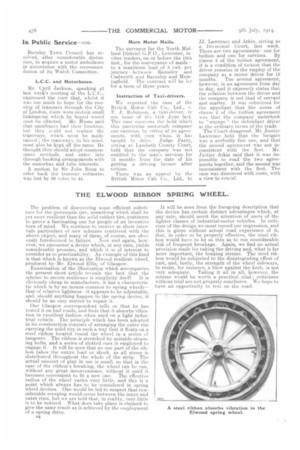THE ELWOOD RIBBON SPRING WHEEL.
Page 20

If you've noticed an error in this article please click here to report it so we can fix it.
The problem of discovering seine efficient substitute for the pneumatic tire, something which shall be yet more resilient than the solid-rubber tire, continues to prove a fascinating one for people of an inventive turn of mind. We continue to receive at short intervals particulars of new schemes contrived with the above object, and many of them, of course, are obviously foredoomed to failure. Now and again, however, we encounter a device which, at any rate, yields considerable promise, and which it is of interest to consider as to practicability. An example of this kind is that which is known as the Elwood resilient wheel, produced byMr. Elwood Ellis, of Glasgow.
Examination of the illustration which accompanies the present short article reveals the fact that the scheme to secure resilience is simplicity itself. It is obviously cheap to manufacture, it has a characteristic which is by no means common to spring wheels-that of relative lightness • -it appears to be adjustable, and, should anything happen to the spring device, it should be an easy matter to repair it.
Our Glasgow correspondent tells us that he has tested it on bad roads, and finds that it absorbs vibration in excellent fashion when used on a light industrial vehicle. The principle which has been adopted in its construction consists of arranging the outer rim carrying the solid tire in such a way that it floats on a steel ribbon located round the wheel in a series of tangents. The ribbon is stretched by suitable. straining bolts, and a series of slotted ears is employed to engage it. It will be seen that no one part of the ribbon takes the entire load or shock, as all stress is distributed throughout the whole of the strip. The actual amount of play in nse is small, so that in the case of the ribbon's breaking, the wheel can be run, without any great inconvenience, without it until ii becomes convenient to fit a new one. The effective radius of the wheel varies very little, and this is a. point which always has to be considered in spring Wheel devices. One would be led to suspect that considerable creeping would occur between the inner and outer rims, but we are told that, in reality, very little is to be noticed. What does take place is claimed to give the same result as is achieved by the cmaployment of a spring drive.
D4 It will be seen from the foregoing description that the device has certain distinct advantages which, at any rate, should merit the attention of users of the lighter classes of industrial-motor vehicles. In criticism of the design we must record our impression, and this is given without actual road experience of it, that, in order to be properly effective, the steel ribbon would have to be so thin as to run considerable risk of frequent breakage. Again, we find no actual provision made for taking the driving and, what is far more important, the braking strains. The steel ribbon would be subjected to the disintegrating effect of rust, and, lastly, the strength of the wheel sideways, to resist, for instance, a blow against the kerb, is not very adequate. Taking it all in all, however, the scheme would be worth a practical trial; criticisms without trial are not properly conclusive. We hope to have an opportunity to test on the road.


























